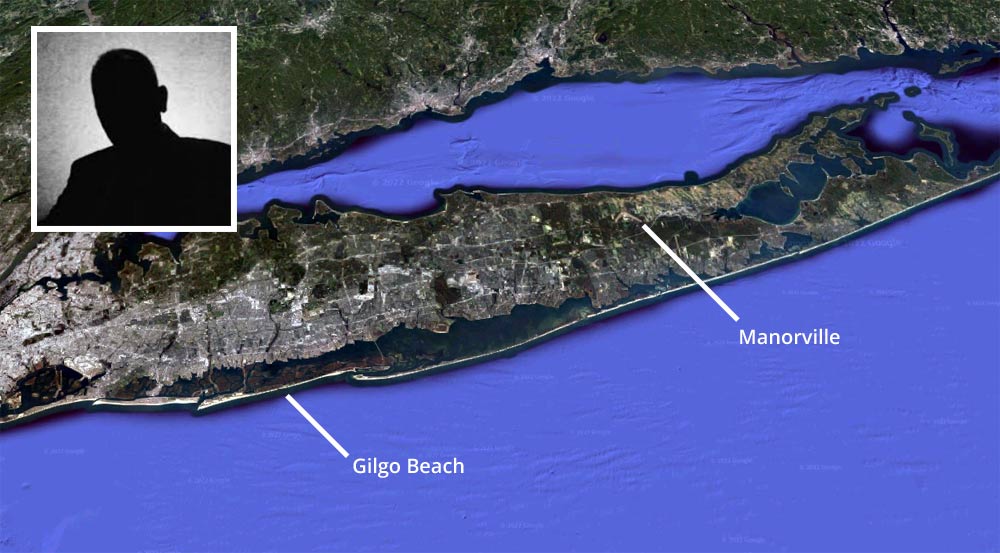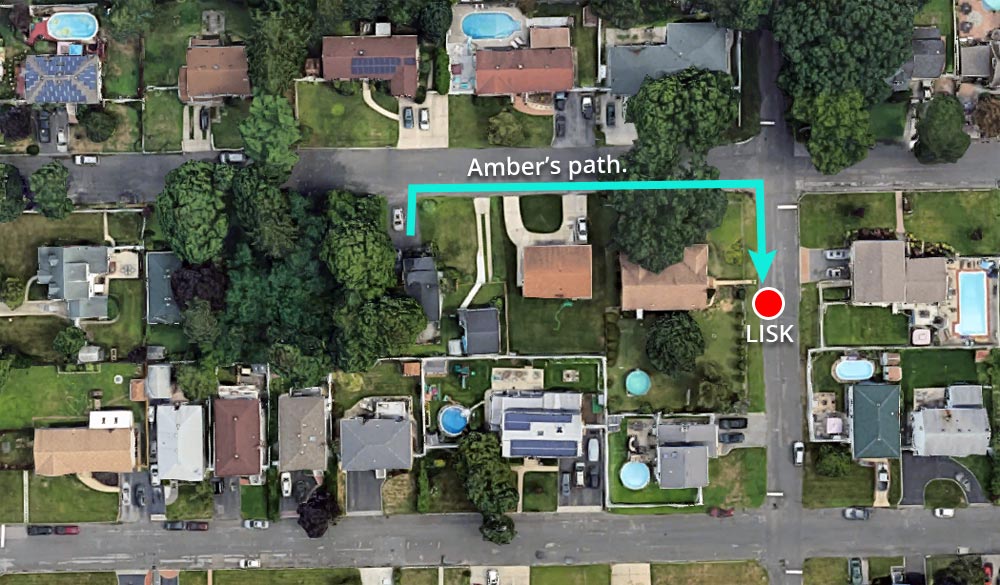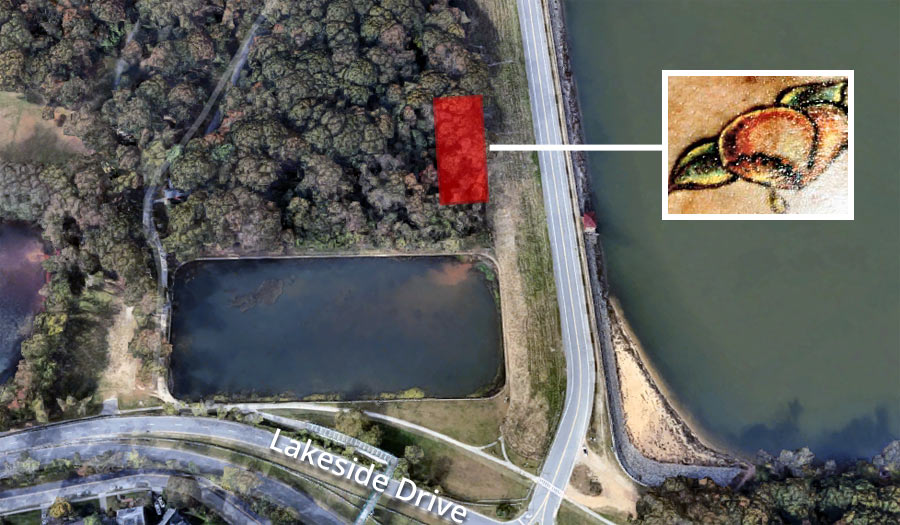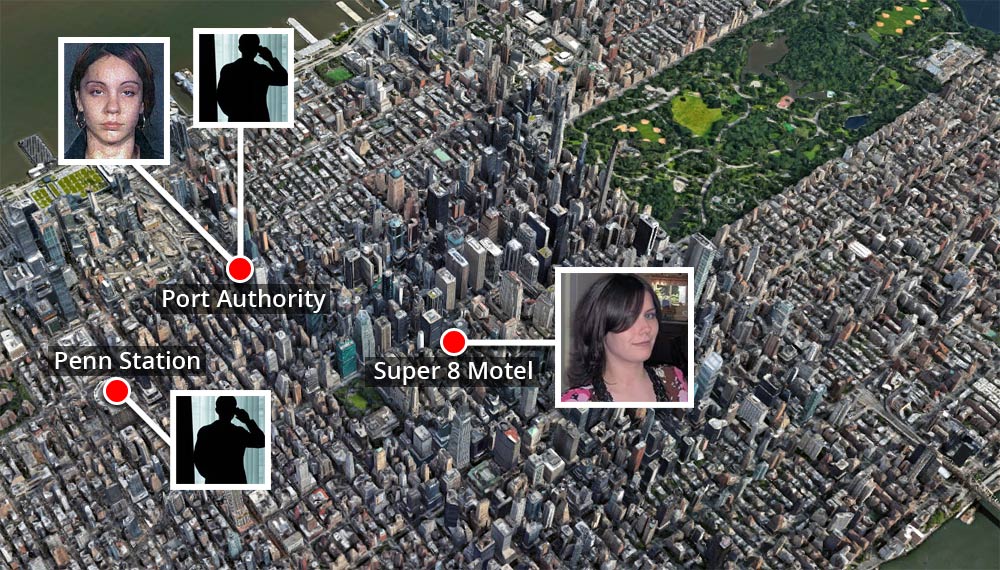Over the past decade, there have been a number of different theories about who the Long Island serial killer is. Criminologists, former FBI agents, and amateur detectives have all published their own criminal profiles of “LISK”.
Unfortunately, profiles can be misleading. This is because they tend to rely on probability.
According to the “Coals to Newcastle” study by policing strategist and former Detective Chief Inspector Gary Copson, offender profiling is roughly 66% accurate.
As a result, we must never take a profile as fact. Instead, we should view it as a useful guide.
We can use a criminal profile to help us narrow in on a suspect. However, we should never use it to rule someone out.
In this article, we will scrutinize some of the most common theories about the Long Island serial killer. We will also offer some of our own insights and theories.
Our goal here is to try and stick to the facts, weed out any assumptions, and present a grounded and peeled-back “profile” of who the killer is without making any large leaps of logic.
Note that this profile was first published on March 7th, 2022. Our last major revision was in September of 2022.
Is the Long Island serial killer a member of law enforcement?
The theory that the Long Island serial killer might be a member of law enforcement is based on three key facts:
- He attempted to conceal some of his victims’ identities by dismembering their bodies.
- Investigators seemingly failed to find any DNA evidence on his victims’ remains.
- He is aware that the police have the ability to track cellphones and phone calls.
Although this shows us that he understands how the police are able to narrow in on suspects, it does not prove that he is a member of law enforcement.
Detective magazines, documentaries, true crime books, movies, and TV shows have all touched on these subjects in the past.
For example, the documentary series “Forensic Files” aired between 1996 and 2011. The CSI franchise also exploded in popularity during the 2000s.

True crime shows, documentaries and magazines have been popular for decades.
The general public is well aware that the police can trace phone calls and match DNA evidence against bodily fluids and hair. Furthermore, there are plenty of examples where murderers decided to dismember their victims’ bodies.
For example, Ted Bundy decapitated one of his victims in a deliberate attempt to hinder her identification.
All in all, we cannot stubbornly cling to the theory that LISK is a police officer. We must remain open-minded and accept the fact that a member of the public is capable of learning about these things.
The killer knows Gilgo Beach and Manorville.
Serial killers tend to operate in comfort zones. Therefore, there is a very good possibility that the Long Island serial killer is familiar with both Gilgo Beach and Manorville.
These are two areas where the authorities discovered more than one victim.

LISK has dumped his victim’s remains at Gilgo Beach and Manorville.
Operating in an unknown area is risky if you are committing a serious crime. From the offender’s perspective, there are far too many unknown variables.
Who will be there? How busy is it at certain times? How likely is it that someone will immediately stumble across the body? If someone does show up while I’m there, what should I do? Is there an alternative exit? If I park my car by that entrance, will someone see it? If a local does see it, will they become suspicious?
These are just some of the questions that will be going through the offender’s mind. An unknown area is risky because he might not have enough knowledge to answer those questions.
As a result, he will usually only operate in areas that he is somewhat familiar with.
Remember that committing a serious crime is a stressful act, even if you are a remorseless serial killer. The stakes are extremely high. One false step and you might spend the rest of your life behind bars.
Valerie Mack.
A group of hunters discovered the torso of suspected LISK victim Valerie Mack at a site in Manorville in November of 2000.
Newspaper articles reported that Valerie Mack’s killer dumped her near the intersection between Mill Road and Halsey Manor Road.
However, this is slightly misleading. Crime scene photographs show that the dump site was actually much further away from the main road.
In other words, he didn’t just dump her torso at the roadside and then drive away.

This is an aerial image of the dump site. The red circle indicates the general area where the Long Island serial killer dumped Mack’s remains. The blue circle shows the intersection between Mill Road and Halsey Manor. Most online maps erroneously place her remains close to the blue circle. Inset is a Google Street View image of the entrance.
In this case, the killer entered a wooded area through an obscure entrance and then drove along a powerline access road for 0.5 miles.
According to locals, this is not the type of place that a stranger to the area would choose to drive through, especially if it was late at night and they had human remains in their vehicle.
Notably, Google Street Map images show that there are no street lights in the area.
This suggests that the killer has visited this particular location in the past. For example, he might be a hunter, a hiker, a utility worker, a wildlife enthusiast, or an environmentalist.
In any case, it seems as though this person is familiar with the woods around Manorville and is no stranger to the great outdoors.
Due to the terrain involved, it is likely that LISK was driving a van or a truck.
He targets sex workers because they are accessible and vulnerable.
Like many serial killers, LISK targets sex workers because they are often more vulnerable and easier to access than the average woman.
Furthermore, they tend to move around a lot. When a sex worker goes missing, people will often presume that they have gone elsewhere.
For example, she might be in and out of rehab due to a drug addiction. She might regularly switch between living with her parents and couch-surfing. There might also be other “push factors”, such as an abusive relationship with a boyfriend and/or pimp.
Killing sex workers instead of “regular women” also allows him to rationalize his crimes. This makes it easier for him to compartmentalize his “hobby” from the rest of his life.
The Long Island serial killer is a sadist.
A week after LISK victim Melissa Barthelemy went missing, an unidentified man started to make a series of “descriptive” calls to her younger sister Amanda.
The man in question made these calls from Melissa’s phone.
During these conversations, the man toyed with Amanda and taunted her about Melissa’s disappearance. Then, in the final phone call, he stated that Melissa was dead and that he was going to “watch her rot”.

Melissa Barthelemy disappeared on July 10th, 2009.
Unfortunately, the authorities were unable to trace these calls.
Not only did he keep the calls relatively short, he purposely made them in crowded areas such as the Port Authority Bus Terminal and Penn Station.
If this was indeed the killer, then it is possible that he is a sadist. In other words, he gets gratification by inflicting pain on others.
In this case, he went out of his way and risked exposing himself just so he could psychologically torture the sister of one of his victims.
He did this over a series of seven phone calls.
In other words, he didn’t just risk it once on a whim. Instead, he launched a sustained psychological attack on the 16-year-old sister of one of his victims.
If this individual is a sadist, then it is likely that those who know him will find him to be cruel, short-tempered, controlling, intimidating, and demeaning at times. He might also exhibit harmful behavior toward living creatures.
Friends, family, and coworkers might notice that he has a fascination with weapons and violence.
Furthermore, he might come across as cold-hearted and hostile towards people he deems inferior.
There were signs that he tortured them.
The phone calls are not the only indication that he is a sadist.
During an interview with “Get Secure” on “The Daily Blu”, former Suffolk County Police Commissioner Richard Dormer stated the killer “spent time with the victims”.
In a different interview with the same host, the former Chief of Detectives, Dominick Varrone, indicated that they had been tortured.
If LISK is a sadist, then it means that he derives pleasure from physical and/or psychological suffering.
In other words, he may have taunted his victims and tortured them.
This is the type of man who would have enjoyed witnessing his victims’ terror when he dropped the nice guy routine and they finally realized that they were in trouble.
In fact, he would have relished that part and looked forward to it—so much so that he may have actively thought about ways to let his mask slip.
On top of the taunting and psychological abuse, there may have been elements of physical torture.
As you can imagine, this is one of the worst kinds of serial killers.
These offenders prefer to prolong the murder. Some of them like to spend hours, or even days, with their victims, depending on how much free time they have.
He is socially adept and able to manipulate others.
In the case of Amber Lynn Costello, he was seemingly able to manipulate his victim into leaving her house without a phone.
According to her roommate, she seemed “familiar” with him. So much so, in fact, that she was willing to suspend her normal rules of operation.
Notably, he offered Amber $1,500 for an overnight stay—a rate that was much higher than usual.

Amber Lynn Costello.
Although there is a possibility that he availed of their services in the past, we cannot be 100% certain of this.
For example, he may have convinced them to suspend their normal rules of operation by simply offering rates that were much higher than normal.
Amber Costello and Maureen Brainard-Barnes were both vulnerable at the time of their murders. Costello had a heavy heroin addiction, and Brainard-Barnes was facing eviction.
This may have influenced them to do an out-call with a client they had never met before.
Regardless of whether he met them before or not, it is pretty obvious that his victims did not consider him to be a threat.
Notably, Costello did not express any worries about this client to her roommate. Nor did Maureen say anything of note when she called her friend and said that she was meeting a man outside of her hotel.
This tells us that he is socially adept and doesn’t come across as strange.
In other words, he fits in well with society and appears quite normal.
This guy isn’t an unhinged weirdo. Instead, he is reasonably normal, calculating, and manipulative. By the time his victim starts to notice any red flags, it is already too late.
He seems to strike during the summer months.
Most of the Long Island serial killer’s victims went missing between June and the start of September.
- Maureen Brainard-Barnes: July, 2007.
- Melissa Barthelemy: July, 2009.
- Megan Waterman: June, 2010.
- Amber Lynn Costello: September 2nd, 2010 – before Labour Day.
- Jessica Taylor: July, 2003.
- Valerie Mack: Last seen in the spring or summer of 2000.
- “Peaches” / Jane Doe No. 3: Murdered in June of 1997.
- Jane Doe No. 7: March or April of 1996.
As you can see, his first known victim “Jane Doe No. 7” is the only woman who disappeared outside of the summer period.
Why does he only seem to strike during the summer?
There are a number of possible reasons for this.
- He is a seasonal visitor to the area. For example, he owns a holiday home in the area.
- He lives in the area. However, his family is away during the summer.
- The brighter evenings provide him with an excuse to stay out later than usual without raising any suspicions. For example, he might be an outdoor worker.
- During the summer months, the roadside bushes where he likes to dump his victims’ remains are thick with leaves. In other words, he knows that months will pass before the branches become bare.
- Something happens during these months that stresses him out. For example, his workload increases or a family event occurs.
- A hobby or activity that provides him with stress relief is not accessible during these months.
- He works in an occupation that gives him a lot of free time during the summer. For example, he might have a job at a university or school. He might also work as a school bus driver.
- There is a seasonal aspect to his sexual fantasy.
- He might have a designated “kill site” that is “exposed” or inaccessible in the winter. That or the ruse he employs to lure them there isn’t as credible during the colder months.
- He has an alibi for being in Gilgo Beach during the summer. For instance, he might work in that area during those months.
As you can see, there are a number of possible reasons why the Long Island serial killer only seems to kill during the summer.
Does LISK have access to burlap?
The “Gilgo Four” victims were reportedly wrapped in burlap.
This has led to the theory that LISK works in an occupation that provides him with easy access to burlap. That or he has a hobby that puts him in regular contact with the material.
Although this is possible, it is important to point out that he only needed to have access to it at one singular point in time.
For example, a gardener or contractor may have left them behind after doing work at his home. Or he could have happened across them somewhere else.

This is an extremely common material with a wide range of uses. Note that the police did not say that the Gilgo Four were dumped in burlap sacks. They said that they were wrapped in burlap.
Manorville and the surrounding area have a well-known illegal dumping problem. Therefore, it is within the realm of possibility that he discovered the material out in the open and decided to keep it.
Furthermore, burlap is a common sight on Gilgo Beach, as the fabric is used to combat beach erosion.
Basically, it would be foolish to rule out suspects based on whether they had regular access to burlap or not.
This is a common material that has a wide range of uses.
He does not have to be well educated.
A criminal profile in the New York Times opined that the Long Island serial killer is well educated. However, this seems like a leap of logic.
A person does not need to have a high level of education in order to learn about forensic science and police investigative techniques.
All they need is access to information and the motivation to absorb it.
In this case, it is likely that the killer has an interest in true crime material. For example, he might watch detective documentaries or read books about serial killers.
It is important to note that he does not need to have extensive knowledge about these subjects in order to thwart the investigation.
For example, he does not need to know about the intricacies of DNA profiling. All he needs to know is that the authorities can trace hair, bodily fluids, and fingerprints.
Similarly, he does not need to be tech-savvy to understand that investigators can track cellphones. One movie scene where the fugitive removes a SIM card is enough.
There is no evidence to suggest that the Long Island serial killer is “high-up”.
A sizable number of people who follow this case seem to be convinced that the Long Island serial killer is some sort of powerful authority figure. That or he is a rich person from the upper echelons of society.
However, there is no solid evidence to back this up.
All in all, it seems as though people want to believe this because it makes the case seem more “exciting” or “dramatic”.
Until there is solid evidence to state otherwise, we must presume that he could be from any social class.
He does not have to be intelligent.
There have been a number of cases where serial killers with average or below-average IQs have successfully evaded law enforcement for lengthy periods of time.
For example, Gary Ridgway’s IQ was in the “low eighties” and he managed to escape justice for 19 years.
In the case of LISK, we should not interpret his cautious nature as evidence that he is more intelligent than the average person.
In reality, he may just have better impulse control than other serial killers. This would explain why he is seemingly able to go for lengthy periods of time without killing anyone.
The assumption that serial killers are unable to stop themselves from killing is a myth. In reality, they can find another outlet for their sexual fantasies. For example, the BTK killer, Dennis Rader, was able to substitute the act of killing with various autoerotic activities.
Having said all of that, he is certainly no “dope”. The way in which he operates suggests that he is cautious and methodical.
LISK was a regular “john”.
In the past, serial killers who primarily targeted sex workers always turned out to be regular clients.
In other words, they frequently hired escorts, most of whom they didn’t harm.
These men were “normal” customers before their murders started, and they continued to be “normal” customers in between killings.
The women that they let go had no idea that their lives were hanging in the balance.
The odds tell us that the Long Island serial killer is almost certainly a regular “john”.
This is a man who has spent a considerable amount of time with escorts. He has hired them, talked to them, driven past them, called them, and poured through their online profiles.
Due to his familiarity with prostitution, his ability to remain dormant for lengthy periods of time, and his need to inflict physical suffering, it is possible that he pays sex workers to engage in activities that satiate his urges.
If this is the case, then there is probably at least one sex worker in the Long Island area who remembers a “reliable” and seemingly nonthreatening client who paid extra money for consensual BDSM activities, rough sex, or other unusual requests.
For example, he might have asked her to act out certain violent scenarios. Or he may have been into bondage.
The Long Island serial killer is a regular client who only kills when he feels that the conditions are right. If he is unable to pick them up without being seen, then he uses their services as normal.

In Amber Costello’s case, LISK parked around the corner from her house in the hope that no one would accompany her. If her roommate did walk her to the car, or a neighbor exited their house, he probably would have paid for her services as normal. However, that night, it was dark, no one was around, and Amber turned the corner by herself.
LISK is familiar with Manhattan.
The Long Island serial killer seems to be pretty familiar with Midtown Manhattan.
Five separate events suggest that he is no stranger to the area:
- His fourth known victim, Jessica Taylor, was last seen working around the Port Authority bus terminal between July 18th and July 22nd, 2003.
- Maureen Brainard-Barnes disappeared on July 9th, 2007 after a client picked her up outside of a motel on West 46th Street.
- In 2009, Melissa Barthelemy’s sister received an anonymous phone call from a man who was at the Port Authority. It is presumed that the man in question was LISK.
- This man also called her from Penn Station.
- His third victim, Valerie Mack, reportedly traveled to New York shortly before her disappearance.
This “familiarity” strengthens the theory that LISK is a regular “john”, as the area around Times Square has had a long-standing reputation for prostitution.
Notably, the first victim (that we know of) that went missing from Long Island was Megan Waterman, who was picked up outside of the Holiday Inn Express in Hauppauge on June 6th, 2010.

Waterman’s case is the first known instance of LISK picking up a victim on Long Island.
This suggests that Manhattan may have been his original hunting ground, and that he didn’t start picking up sex workers on Long Island until the late 2000s.
If this is true, then it means that the killer is a Long Islander who has been frequenting Manhattan for sex workers since the 1990s. By using Manhattan, he was able to lower his risk of being spotted by a family member, friend, or coworker.
In other words, he was able to put a safe distance between his “hobby” and his home base.
The anonymity of the big city, its reputation for prostitution, and its proximity to Long Island would have made it an alluring destination for him.
In the offender’s mind, there are two conflicting thought processes at play:
- “Operating in a place that is too far away is risky, as I do not know the lay of the land. It also requires far more effort.”
- “Operating too close to home requires less effort. However, it is also risky, as there is an increased chance that someone I know will identify me.”
This “tug-of-war” may have led him to the Big Apple, which is just a short drive away from Long Island.
His decision to start picking up victims closer to home may have been influenced by his new-found use of Craigslist, which removed the need for him to approach sex workers in public.
This gave him far more control over the “pick up”, thereby lowering his exposure.
It is likely that he is a family man.
Consider the following:
- It seems as though he deliberately put a safe distance between his “hobby” and his hometown.
- He used disposable burner phones, which were extremely popular tool among married “johns”.
- There is a noticeable hiatus between each kill.
It is likely that his behavior as a serial killer was an extension of his behavior as a “john”.
For example, if he picked up his earlier victims in Manhattan, then it means that he probably picked up other escorts there as well.
As we pointed out above, offenders will usually try to stick to places that they are somewhat familiar with.
Therefore, it is likely that he started using Manhattan to pick up sex workers long before he started using it to pick up victims.
In other words, it was his experience of picking up girls there that gave him the confidence to start utilizing it as a hunting ground.
This means that in the period before he started killing, he deliberately chose to put a sizable distance between his “hobby” and his hometown.
This level of caution suggests that he had a lot to lose. More specifically, a girlfriend or wife.
In his mind, picking up sex workers on Long Island was too risky, as there was a higher chance that someone he knew would see him in the presence of another woman and tell his significant other.
Consequently, he drifted towards Manhattan—a large, bustling city where he could get lost among the crowds.
Burner phones.
This theory is strengthened by his use of burner phones, which were a popular tool among married “johns”—so much so that they regularly discussed the topic on anonymous message boards.
When prostitution moved online, many of these men quickly realized that using their own personal phones to contact escorts was far too risky.
As a result, they resorted to using cheap, prepaid phones that they could easily purchase at any department store.
This raises the possibility that the Long Island serial killer originally started using burner phones as a means to hide his “hobby” from his wife or girlfriend.
Hiatus.
To add to all of this, there is a noticeable hiatus between each victim.
This suggests that he had other things going on in his life (such as raising children).
This wasn’t an unemployed loser who had a lot of time on his hands. Instead, he was most likely a busy family man who could only get away at certain points.
Remember that this guy was most likely a sadist. This, combined with his cautious nature, meant that he preferred to spend a considerable amount of time with his victims. Not just because of his needs but also because he had to clean things up and dispose of the remains in a safe way that didn’t tie back to him.
In other words, he couldn’t just kill someone quickly, dump them on the side of a random road, and be home in time for dinner.
The hiatus between kills is most likely a reflection of his time constraints.
Due to work and family life, he only had certain windows of opportunity.
He wasn’t an impulsive creature like Ted Bundy, who was basically an unemployed, functional alcoholic who had very few commitments and a lot of free time on his hands.
The Long Island serial killer changed his M.O.
The Long Island serial killer went from dismembering his victims and dumping their remains at separate locations to dumping their entire bodies in burlap at one location on Gilgo Beach.
He also started to target sex workers who were advertising their services on Craigslist instead of women who engaged in street prostitution.
This change in M.O. occurred during the murder of Maureen Brainard-Barnes in July of 2007.

Maureen Brainard-Barnes went missing on July 9th, 2007.
Brainard-Barnes was the first victim that LISK did not dismember. She was also the first victim that he targeted via the Internet.
There are a number of possible reasons why he decided to change his M.O.
Jessica Taylor was the first victim who the authorities were able to identify.
In 2003, the authorities were able to identify the torso of a sex worker named Jessica Taylor. This was despite the fact that he had gone through the effort of mutilating an identifiable tattoo on her body.
The discovery of Taylor’s identity would have undoubtedly filled him with worry.

The torso of Jessica Taylor was found at the end of an access road in Manorville in July of 2003.
Now that investigators had a name, there was a chance that they would be able to trace her last known movements and identify him.
If someone saw her talking to him or a CCTV camera captured his vehicle registration number, he was in trouble.
Between 2004 and 2005, he probably spent a lot of time worrying if the police were going to show up at his door.
All of this served as a wake-up call. He now knew that law enforcement had the ability to identify his victims’ remains without dental records or fingerprints.
At the same time, he may have also started to realize that approaching sex workers in public was a risky move. All it would take was one eagle-eyed bystander to turn his entire world upside down.
LISK’s Gilgo Beach dumpsites remained undiscovered.
Back in 2007, his dumpsites on Gilgo Beach remained undiscovered.
As a result, he grew increasingly confident in the area.
At some point, it seems as though he arrived at the conclusion that he no longer needed to dismember his victims and dump their remains at different locations. Instead, he decided to wrap their bodies in burlap and dump them at the roadside by Ocean Parkway.
In his mind, dismemberment was no longer worth the hassle.
LISK had far less exposure with the Gilgo Four.
The Long Island serial killer’s earlier victims worked on the street. This means that he would have had to approach them in public.
This left him somewhat exposed. Although he was probably as careful as he could be, there was always the possibility that someone would remember seeing the victim getting into his vehicle.
This is why he went to such lengths to conceal their identities.
If the police do not know a victim’s identity, they can’t track their last known movements.
However, with the Gilgo Four, it was different. In the lead-up to their murders, he was able to keep a safe distance by finding them on Craigslist and then contacting them using burner phones. At that point, he was able to lure them to places where he could pick them up unnoticed.
This gave LISK far more control over the situation.
Consequently, he may have no longer felt the need to obscure their identities. In his mind, it didn’t matter because the authorities had no way of connecting him to them.
He pays attention to news coverage of his crimes and adapts his M.O. accordingly.
In 1996, he put Fire Island Jane Doe’s legs into a plastic bag and threw them into the bay. A couple of weeks later, two men spotted the bag after it washed up on a beach on Fire Island.
After this discovery, it seems as though he stopped using the bay to dump identifying remains.
In 1997, he dumped the torso of an unidentified woman (Peaches) in Hempstead Lake State Park. In an effort to identify the woman, the authorities published a photograph of her tattoo in local newspapers.
From that point on, he started to mutilate or obscure his victims’ tattoos.
In 2000, LISK chopped off Valerie Mack’s right foot before he dumped her torso. The police believe that he may have done this to hide a tattoo on her ankle.
Three years later, in 2003, the torso of Jessica Taylor was found in Manorville. In Taylor’s case, he attempted to hide a tattoo on her body by cutting it with a knife. Fortunately, the medical examiner’s office was able to piece it back together. This eventually led to her identification.
After Taylor was identified, he decided to stop dumping his victims’ remains out in the open. He also stopped approaching girls on the street.
As you can see, he seemingly adapted his M.O. with each development in the case.
Notably, when a Buffalo news station reported on his phone calls to Melissa Barthelemy’s sister, the calls suddenly stopped.
All of this shows us that he actively pays attention to the news coverage about his crimes.
If this is true, then it is likely that he frequently Googles the case, its victims, and the officers who are in charge of it. He might even frequent message boards that discuss it. There’s also a very good possibility that he collects news clippings about the murders.
If he is still out there, then it is likely that he found this article before you did.
The Long Island serial killer wanted his victims’ torsos to be found.
In the cases of “Peaches”, Valerie Mack and Jessica Taylor, it seems as though the Long Island serial killer strategically placed their torsos in areas where he knew someone would find them.

The killer dumped Peaches’ remains just inside this treeline. It was next to a main road and a walking trail.
Although he dumped Valerie Mack’s remains “off the beaten track”, it was right beside a pathway that is popular among hunters.
- Peaches (1997): A local man finds her torso just a few feet inside the treeline at Hempstead Lake State Park, close to a main road.
- Valerie Mack (2000): Three pheasant hunters discover her torso near a powerline access road.
- Jessica Taylor (2003): A dog walker discovered her remains on top of a pile of branches at the end of an access road.
It is telling that he went to great lengths to dismember their bodies and hide their identifying remains, yet seemingly did the opposite when it came to disposing of their torsos.
This suggests that he wanted some form of attention.
For example, he may have enjoyed seeing his crimes on the news or hearing people talking about them. He might have even wanted people to connect the dots between his crimes and realize that a serial killer was among them.
This kind of behavior is incredibly common among serial killers, as it gives them psychological gratification.
It is an “added bonus”, so to speak.
For example, the “Kansas City Strangler,” Lorenzo Gilyard, “forced” the discovery of Sheila Ingold’s remains by pretending to be an innocent passerby who was interested in buying the van that he had dumped her remains in.
By pretending to be interested in buying the van, he was able to trick the owner into opening the side door and revealing her body.
A sadistic serial killer named Maury Travis was so desperate for media attention that he sent a local newspaper a map that pinpointed the location of one of his victims’ bodies.

A woman discovered Jessica Taylor’s remains at the end of this access road on Halsey Manor Road while she was walking her dog. Notably, he decided to leave them out in the open. He could have easily dumped the torso inside the treeline, which was just a couple of feet away.
Above, we mentioned that there is a very good possibility that LISK is a sadist.
If this is indeed the case, then this kind of behavior should not come as a surprise.
According to forensic psychologist Richard Walter, sadists in particular get a “kick” out of playing cat-and-mouse games with the authorities. They also enjoy striking fear into the wider community.
While speaking about Jessica Taylor’s murder, one Manorville resident stated:
“If you live here and you know the woods, you wouldn’t pull over and leave [a torso] practically on the side of the road. Unless you want it to be found.”
Shortly after Taylor’s remains were found, a police spokesperson made a similar statement:
“It doesn’t really seem like [the killer] was concerned that the body would be found. It certainly would not be a place to put a body if you were looking to hide it.”
He may have started conversations about his crimes.
If any of the above is true, then it is possible that “the unsub” was eager to initiate conversations about his crimes with others.
Friends and coworkers may have noticed that he was overly enthusiastic about discussing them.
The only anomaly here is his first known victim, Fire Island Jane Doe. Although her legs and skull were eventually found, her torso remains missing to this day.
Judging by his behavior in the other three cases, it is possible that he dumped her torso in a public place and that it was somehow overlooked. For example, someone somewhere may have come across a plastic bag and presumed that it was a dead animal.
It is also possible that he miscalculated and placed it too far out of the way.
Interestingly, in the case of Valerie Mack, it seems as though he was unhappy that it took so long for someone to find her remains. As a result, he made sure to dump his next victim, Jessica Taylor, in a much more public place.
However, Taylor’s identification came as an unwelcome surprise to him. Although he had mutilated an identifiable tattoo on her body, the medical examiner’s office was able to piece it back together.
This development convinced him that he was flying far too close to the sun.
Playing games is fun until you start worrying about police vehicles pulling into your driveway.
The belt.
The police discovered a belt with initials on it at the Gilgo Four dumpsite. In another article, we opined that LISK purposely placed the belt there as a misdirection.
In other words, this may have been his way of continuing his cat-and-mouse games with the authorities at a much lower risk.
Poison ivy.
According to a criminal profile published in the New York Times, LISK may have sought treatment at a hospital for poison ivy.
This is because the dense thicket on the north side of Gilgo Beach is full of poison ivy.

The remains of Megan Waterman were discovered in this section of the thicket on Ocean Parkway.
The logic here is that he would have been unable to avoid exposure unless he took certain precautions.
However, it is worth pointing out that poison ivy affects some people more than others. In fact, 25% of people will experience no reaction at all.
For all we know, he experienced mild symptoms that barely phased him.
If he is familiar with the great outdoors, then it stands to reason that he knows the old saying: “Leaves of three, let it be.”
Internet usage.
His usage of the Internet to contact the Gilgo Four victims has led some people to posit the theory that he is good at using computers.
However, this theory ignores the wider societal changes that were taking place during the 2000s.
During the 2000s, Internet usage in the United States increased rapidly. Furthermore, smartphones with Internet access exploded in popularity in the second-half of the decade.
Websites such as MySpace, YouTube and Craigslist were all gaining millions of new users every year.
Between 2000 and 2010, the number of American adults who used the Internet increased from 52% to 76%. This increase was even more pronounced in older age groups.
Basically, this means that the Long Island serial killer does not have to be proficient with computers. For all we know, he is someone who merely followed the wider trend.
Who is the Long Island serial killer?
If there’s one thing that this “profile” makes very clear, it’s that the Long Island serial killer case is extremely fluid and that there isn’t a lot of publicly-available information about the perpetrator.
All we know is that he is adaptable, relatively cautious and knowledgeable about investigative techniques. He may also be a sadist who is familiar with Manorville, Gilgo Beach and Midtown Manhattan.
It is likely that this man has used the services of sex workers in the past without causing them any harm. If he is a sadist, then he has probably paid extra for “unusual” requests.
This opens up the possibility that he has a sizable amount of disposable income. However, it does not necessarily mean that he is “rich”. For example, he might own a local business or be employed in a well-paying job.
The location of Valeria Mack’s torso suggests that he is a hunter or someone else who regularly visits the area around the Long Island State Pine Barrens. Judging by the terrain, he might drive a truck or another 4×4 vehicle.
His habit of dumping his victims’ torsos out in the open suggests that he was seeking some form of attention. If this is true, then he probably initiated conversations about the crimes with others.
Judging by the dates that his victims went missing, it seems as though he prefers operating during the summer months. However, we have no idea if this is because of necessity or choice.
Although he did have access to burlap at one point in time, there is no way to tell if he had regular access to it or not.
His usage of burner phones and his decision to put distance between his hometown and his “hobby” indicates that he is a family man. This is backed up by the noticeable pauses between kills.
Is LISK still around?
The Long Island serial killer’s last confirmed victim went missing in September of 2010.
There are four possibilities here.
- He is in prison for another crime.
- He is dead or seriously ill.
- The find at Gilgo Beach spooked him so much that he decided to go dormant.
- He is now operating elsewhere.
Let’s hope that it is number one or two.
